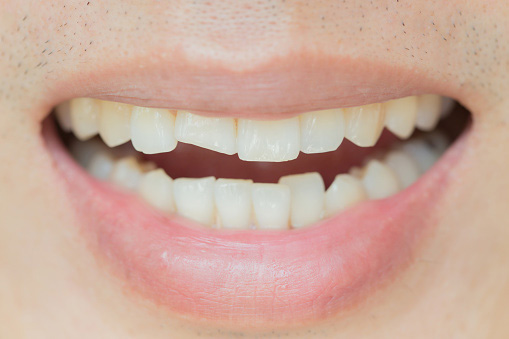Cracked Teeth
 When your tooth cracks, you may experience cracked tooth syndrome or a fractured tooth. The fissure may be minor and unobtrusive. Sometimes it can create a crack or split in your teeth. Everyone is susceptible to cracking a tooth, although children and the elderly are more likely to experience tooth fractures. When your tooth cracks, you may experience cracked tooth syndrome or a fractured tooth. The fissure may be minor and unobtrusive. Sometimes it can create a crack or split in your teeth. Everyone is susceptible to cracking a tooth, although children and the elderly are more likely to experience tooth fractures.
Root Causes of Cracked Teeth
Many things can cause a tooth to crack, including:
| • |
Grinding teeth puts pressure on the tooth's roots.
|
| • |
Having a filling that is too large weakens the tooth's structure.
|
| • |
Chewing or biting on something extremely hard.
|
| • |
Getting a blow to the mouth due to a car accident, a sports injury, or a fall.
|
| • |
Experiencing sudden, extreme changes in mouth temperature. |
Our doctors and our doctors can detect the root cause of the cracked root and offer their insights to you.
Which Part of the Mouth Gets Affected as a Result of Cracked Teeth?
There are two main components to a set of teeth:
| • |
A tooth's crown where you can see the gums.
|
| • |
The roots in your gums. |
There are many levels in the crown and the root:
| • |
Enamel has a tough, white exterior.
|
| • |
Dentin is the layer of the tooth that lies in between the enamel and the pulp.
|
| • |
The pulp is the innermost layer and is made up of blood vessels and nerves. |
When a tooth cracks, it can impair any or all of these levels. The location and severity of the crack will determine how the tooth is treated.
Symptoms of Cracked Tooth Syndrome
There may be no outward signs of a cracked tooth. When this occurs, the most common signs are:
| • |
Periods of discomfort, most notably while biting down
|
| • |
Irritability caused by temperature swings or consuming sugar
|
| • |
A toothache caused by inflammation
|
| • |
Bad toothache that makes it uncomfortable to chew |
What Does a Doctor Do if You Crack Your Tooth?
| • |
See whether any teeth were knocked out or shattered
|
| • |
Take a close look at your teeth for any signs of cracks.
|
| • |
Be on the lookout for gum inflammation, as this could be an indication of irritation from vertical fractures. |
Types of Cracked Teeth
Your dental professional will use one of the following five classifications to describe your fracture:
| • |
A cracked tooth has a fissure that extends vertically from the chewing surface to the gums. It's not uncommon for a crack to go down to the gum and root.
|
| • |
Small, fine fissures develop in the enamel of your teeth, a condition known as hairline cracks.
|
| • |
Cracking around a dental filling is called a fractured cusp. Cusp fractures are not typically particularly uncomfortable.
|
| • |
If your tooth is split, the crack goes down to the gums. Your tooth breaks in half due to this crack.
|
| • |
When a tooth's root fractures vertically, the damage begins at the gum and progresses toward the biting surface. A tooth with a vertical root fracture may not hurt until it becomes infected. |
What Should I Do in Case of Cracked Teeth?
If you want to reduce swelling in your mouth, you should apply an ice pack to the outside of it. Clean your teeth with a saltwater rinse. Take pain relievers and anti-inflammatory medications to help with the swelling and discomfort.
Prevention From Cracked Teeth
All tooth fractures can't be avoided. But with careful dental care, you can lessen your chances of developing crack tooth syndrome:
| • |
Take it easy on chewing ice and eating tough foods.
|
| • |
Maintain healthy teeth and gums.
|
| • |
If you play contact sports or clench your teeth at night, get a custom mouth guard to protect your teeth.
|
| • |
Don't put off visiting the dentist. |
At Cambridgeside Dental Associates, we provide our patients with exceptional services to ensure their cracked teeth heal quickly. Call us at 857-588-1210 to get more information.
|
 When your tooth cracks, you may experience cracked tooth syndrome or a fractured tooth. The fissure may be minor and unobtrusive. Sometimes it can create a crack or split in your teeth. Everyone is susceptible to cracking a tooth, although children and the elderly are more likely to experience tooth fractures.
When your tooth cracks, you may experience cracked tooth syndrome or a fractured tooth. The fissure may be minor and unobtrusive. Sometimes it can create a crack or split in your teeth. Everyone is susceptible to cracking a tooth, although children and the elderly are more likely to experience tooth fractures.